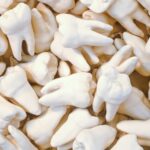What is Temporomandibular Joint (TMJ)
When it comes to the intricate mechanisms of our bodies, the temporomandibular joint (TMJ) is a fascinating yet often overlooked component. This vital joint plays a pivotal role in enabling us to perform everyday actions like chewing, speaking, and even expressing emotions. In this article, we’ll delve into the world of the temporomandibular joint, exploring its functions, common disorders, and methods of relief.
Do you ever feel like your jaw joints are a mystery? It’s time to start cracking the code on TMJ (temporomandibular joint) health. In this blog post, we’ll be exploring the anatomy and physiology of the TMJ, as well as how to apply this knowledge to promote optimal jaw joint health. Read on to learn more about unlocking the secrets of the TMJ!

Anatomy of the Temporomandibular Joint (TMJ)
The temporomandibular joint, also known as the TMJ, is a crucial structure that plays a significant role in our daily lives. Situated on both sides of the face, just in front of the ears, the TMJ connects the lower jawbone (mandible) to the skull. This unique joint allows for the opening, closing, and lateral movements of the mouth, enabling us to perform essential functions such as chewing, speaking, and swallowing.
Understanding the anatomy of the TMJ is essential to comprehend how these joint functions and to appreciate the intricate mechanisms at play. The TMJ is composed of several key structures that work together seamlessly to enable smooth movement. The mandibular condyle, a rounded bony prominence at the end of the lower jawbone, articulates with the temporal bone of the skull to form the joint. Between these two bony surfaces lies a thin disk made of cartilage, known as the articular disk, which provides cushioning and allows for smooth gliding movements. Surrounding the joint is a fibrous capsule that holds everything together and provides stability.
The anatomy of the TMJ is further supported by several ligaments and muscles that contribute to its movement and stability. The lateral ligament, located on the outer side of the joint, helps limit excessive jaw movements. Additionally, the sphenomandibular ligament and the stylomandibular ligament aid in supporting the joint from different angles. It is crucial to note that the TMJ is not just a joint but a complex system involving other structures such as blood vessels and nerves. These structures provide the necessary blood supply and nerve innervation to the TMJ, ensuring its proper functioning.
The temporomandibular joint (TMJ) is not just a simple hinge joint. It’s a complex system that relies on a steady blood supply and nerve innervation to ensure its proper functioning. Understanding the blood supply and nerve supply to the TMJ is crucial in unlocking the secrets of jaw joint health.
Blood Supply
The blood supply to the TMJ is primarily provided by branches of the external carotid artery, a major artery in the neck. These branches, known as the maxillary artery and the superficial temporal artery, play a vital role in delivering oxygen and nutrients to the joint. The maxillary artery gives off small branches that penetrate the TMJ capsule, while the superficial temporal artery supplies the surrounding muscles and tissues.
Nerve Supply
The nerve supply to the TMJ is facilitated by branches of the trigeminal nerve, particularly the mandibular division. The trigeminal nerve is the fifth cranial nerve and is responsible for sensory information from the face and motor control of the muscles involved in chewing. The mandibular division, specifically, carries nerve fibers that innervate the muscles of mastication, as well as the TMJ itself. These nerves allow for the transmission of sensory information and control the movement of the joint during chewing, speaking, and swallowing.
The proper blood supply and nerve innervation are essential for maintaining the health and functionality of the TMJ. Any disruptions or impairments in these systems can lead to various TMJ disorders and discomfort. It’s important to prioritize the health of the blood vessels and nerves supplying the TMJ by practicing good overall health habits, such as maintaining a balanced diet, staying hydrated, and avoiding habits like excessive gum chewing or teeth grinding that can strain the joint.
In summary, the TMJ is a complex joint that relies on a steady blood supply and nerve innervation for optimal functioning. Understanding the blood supply and nerve supply to the TMJ is key to unraveling the secrets of jaw joint health and preventing TMJ disorders. By taking care of our overall health and well-being, we can support the proper blood flow and nerve function necessary for a healthy TMJ and a pain-free jaw. So let’s crack the code on jaw joint health and unlock the secrets of the TMJ!
Muscles Attached to the TMJ and their Roles in Movement

The temporomandibular joint (TMJ) is not a lone ranger. It relies on the support of several key muscles to enable movement and maintain stability. These muscles, known as the muscles of mastication, play crucial roles in chewing, speaking, and swallowing. Let’s take a closer look at the muscles attached to the TMJ and their roles in movement.
The Masseter muscle
This powerful muscle is located at the side of the face and is responsible for elevating the mandible (lower jaw) during biting and chewing. The masseter muscle is one of the strongest muscles in the human body, and its contraction produces the force needed for effective mastication. It plays a significant role in grinding and crushing food, helping to break it down into smaller, more manageable pieces.
The Temporalis muscle
This muscle is located on the side of the head and spans a large area, extending from the temporal bone to the mandible. The temporalis muscle aids in the elevation and retraction of the mandible during chewing. It also helps maintain the stability of the TMJ by working in conjunction with other muscles.
The Medial Pterygoid muscle
This muscle is located deep within the mouth and assists in the elevation and lateral movements of the mandible. It works in opposition to the lateral pterygoid muscle, helping to maintain the balance and stability of the jaw during chewing and speaking.
The Lateral Pterygoid muscle
This muscle plays a unique role in TMJ movement. It is responsible for initiating the lateral movement of the mandible, allowing us to move our jaws from side to side. The lateral pterygoid muscle is also involved in the protrusion of the mandible, enabling us to jut our lower jaw forward. It works in conjunction with the other muscles of mastication to facilitate smooth and coordinated jaw movements.
The muscles attached to the TMJ are instrumental in the movement and stability of the jaw. The masseter, temporalis, medial pterygoid, and lateral pterygoid muscles work together to allow for efficient chewing, speaking, and swallowing. Understanding the roles of these muscles can help us appreciate the complexity of the TMJ and how it functions as a synchronized system. So, the next time you take a bite of food or engage in a conversation, remember to thank your jaw muscles for their hard work!
Movement of the TMJ

The movement of the temporomandibular joint (TMJ) during speech, chewing, and swallowing is a remarkable display of coordination and precision. As we go about our daily lives, engaging in conversations, enjoying meals, and swallowing effortlessly, we may not even be aware of the intricate movements happening within our jaw joints. So, let’s dive into the fascinating world of TMJ movement and unravel its secrets!
Speech
the TMJ plays a vital role in producing clear and intelligible sounds. As we articulate words, the muscles attached to the TMJ work together to move the mandible, allowing for precise movements of the tongue and lips. The coordinated action of the TMJ and associated muscles enables us to form consonant and vowel sounds, shaping our speech and allowing us to communicate effectively.
Chewing
the TMJ once again takes center stage. As we bite into our food, the muscles of mastication, such as the masseter, temporalis, medial pterygoid, and lateral pterygoid, contract and relax in a synchronized manner. These muscle movements allow for the grinding, tearing, and crushing of food, breaking it down into smaller pieces that can be easily swallowed and digested. The TMJ acts as a hinge, facilitating the up and down movements of the mandible, as well as the lateral movements needed for effective chewing.
Swallowing
may seem like a simple action, but it involves a complex sequence of events that rely on the TMJ. As we prepare to swallow, the tongue pushes the chewed food towards the back of the mouth. The mandible then moves upwards and forwards, closing the jaw and sealing off the oral cavity. The swallowing reflex is triggered, initiating a series of coordinated muscle contractions in the throat, esophagus, and beyond, propelling the food towards the stomach. Throughout this process, the TMJ ensures that the mandible moves smoothly and efficiently, facilitating a seamless swallow.
The movement of the TMJ during speech, chewing, and swallowing is a testament to the incredible design and functionality of our jaw joints. Each movement is carefully orchestrated, allowing us to engage in daily activities without even giving it a second thought. Understanding and appreciating the intricate movements of the TMJ can help us recognize the importance of jaw joint health and take proactive steps to maintain its optimal functioning.
Common Causes and Symptoms of TMJ Disorders
TMJ disorders can be quite debilitating and can significantly impact our daily lives. It’s important to be aware of the common causes and symptoms of these disorders so that we can take proactive steps to prevent and manage them.
Causes
One of the most common causes of TMJ disorders is jaw misalignment. This can occur due to various factors, such as genetics, trauma to the jaw, or poor oral habits. When the jaw is misaligned, it can put excessive stress on the TMJ, leading to discomfort and pain.
Another common cause is excessive teeth grinding or clenching, also known as bruxism. This can occur during the day or night and is often associated with stress or anxiety. The repetitive motion and pressure on the TMJ can lead to inflammation and muscle tension, resulting in TMJ disorders.
Poor posture can also contribute to TMJ disorders. When we slouch or hunch over, it can affect the alignment of our spine and jaw, leading to tension and strain on the TMJ. Additionally, habits like biting nails or chewing gum excessively can put unnecessary strain on the TMJ, increasing the risk of developing TMJ disorders.
Symptoms
The most common symptom is pain in the jaw joint, which can radiate to the surrounding areas such as the face, neck, and ears. This pain can be sharp or dull and may worsen with jaw movement or chewing.
Other symptoms include difficulty or discomfort while opening or closing the mouth, clicking or popping sounds in the jaw joint, headaches, earaches, and even tinnitus. Some individuals may also experience facial muscle fatigue or difficulty in properly aligning the teeth.
It’s important to note that the symptoms of TMJ disorders can vary from person to person and may come and go or worsen over time. If you are experiencing any of these symptoms, it’s crucial to consult with a healthcare professional or a dentist who specializes in TMJ disorders for a proper diagnosis and treatment plan.
In the next section, we’ll discuss how we can apply our knowledge of the TMJ to maintain and improve jaw joint health. Stay tuned!
Applying Knowledge of TMJ to Maintain and Improve Jaw Joint Health

Now that we’ve cracked the code on the anatomy, blood supply, nerve supply, muscles, and movement of the temporomandibular joint (TMJ), it’s time to apply this knowledge to maintain and improve jaw joint health. By understanding how the TMJ functions and the factors that can contribute to TMJ disorders, we can take proactive steps to keep our jaw joints in optimal condition.
One of the key aspects of maintaining jaw joint health is practicing good oral habits. Avoid excessive teeth grinding or clenching, as this can put unnecessary strain on the TMJ. If you find yourself grinding or clenching your teeth during the day or while you sleep, consider using a mouthguard to protect your teeth and relieve pressure on the jaw joint.
Maintaining good overall posture is also crucial for jaw joint health. Pay attention to your posture and make an effort to sit and stand up straight, with your shoulders back and your head aligned with your spine. By keeping your spine and jaw properly aligned, you can prevent unnecessary tension and strain on the TMJ.
TMJ exercises
Incorporating relaxation techniques into your daily routine can also be beneficial for jaw joint health. Stress and anxiety can contribute to teeth grinding and clenching, so finding ways to manage stress can help prevent TMJ disorders. Consider practices such as meditation, deep breathing exercises, or engaging in hobbies that help you relax and unwind.
Maintaining a balanced diet can also support jaw joint health. Consuming foods that are rich in vitamins, minerals, and antioxidants can help promote overall joint health, including the TMJ. Incorporate foods such as leafy greens, fatty fish, nuts, and seeds into your diet to support healthy joints.
If you experience any symptoms of TMJ disorders, such as jaw pain, clicking or popping sounds, or difficulty opening and closing your mouth, it’s important to seek professional help. A healthcare professional or dentist who specializes in TMJ disorders can provide an accurate diagnosis and recommend appropriate treatment options, such as physical therapy, medication, or dental procedures.
For more about Sternocleidomastoid Muscle Click Here
For more about interesting fact do follow Trending Curiosity









1 thought on “Jaw-dropping Facts : Unveiling the Secrets of the Temporomandibular Joint (TMJ)”